Short Selling
Short selling is a speculative strategy that focuses on the decrease of the value of financial security. An opposite strategy to the “classic” one, which instead involves betting on the rise in the value of a particular asset or security.
It is used to speculate on the price of a security that could be in trouble or in other cases – these are more relevant especially in articulated strategies – to hedge, that is to cover oneself from the risk of positions in inverse correlation.
With the arrival of CFD contracts contracts also on the retail investment market, short selling is available to everyone, even to very small investors and – although traditionally considered a tool for more experienced traders – it can be used within certain strategies.
Short selling – main features:
| 📈 Type: | Tool to profit from bear markes |
| 🎯Goal: | Speculating on downtrends, Hedging |
| 💰Commissions: | Spread, interests and/or fixed commissions |
| ⛔Risks: | They depend on the underlying asset – average to high |
| 🥇Best brokers: | eToro, Capital.com, Trade.com, Iq Option |
| ⚡Available with DMA: | Depends on legislation and brokers in your country |
What is short selling: definition
Short selling is the sale of securities that we do not have in our portfolio, in order to bet on their decline. A complex system, but today it is made much simpler due to the fact that it is offered by several brokers for online trading.
- Sale of securities that we do not have in our portfolio
When we decide to proceed with short selling, we are actually technically selling securities that we do not have in our portfolio. We are borrowing them in order to sell them now and buy them back in the future for a profit.
- Low-balling
Short selling exists because it allows you to bet on the decline of a specific security. If we think, for example, that soon gold will lose its value in the markets, we can open a short sale position to bet on the fall of the price.
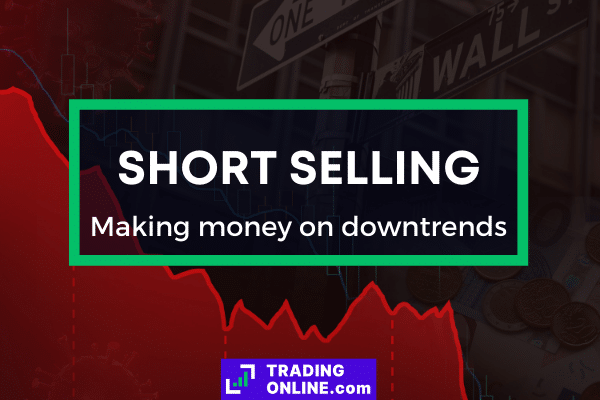
Technically, with the short sale, we are selling gold today that we do not have, in order to reintegrate it with a future purchase. If the price of gold falls in the meantime, we will have made a profit. If the price of gold goes down, we make a profit; if it doesn’t, we make a loss.
- Margin investment
Short selling belongs to all those investment instruments on margin, i.e. investment instruments created to allow us to take a position on the markets by covering with actual capital only a part of the required capital. In this sense, it is the equivalent of leverage, with which many of our readers are already familiar.
- Leveraged investment
The possibility of short selling with leverage depends on the legislation in force in each country. In Europe, ESMA is the body responsible for regulating this aspect; in the United States it is the SEC, in the UK the FCA, and so on. The technique of short investment in combination with leverage is often used mainly for hedging purposes, i.e. to cover the risk of other positions.
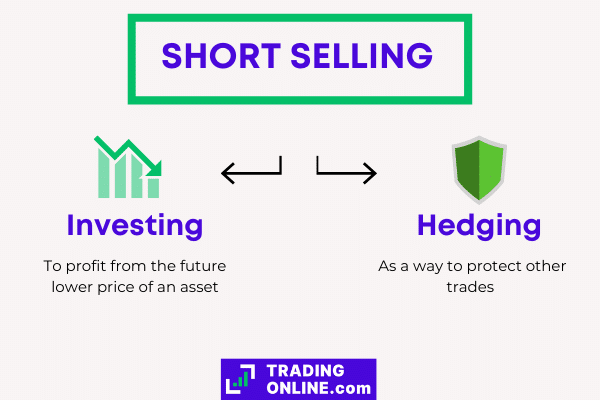
- Using derivatives
Often the most convenient way to invest short in a certain financial instrument is through derivatives. Today you can comfortably choose between several brokers offering CFDs (contracts for difference) that offer this type of service. CFDs constantly follow the quote of the underlying instrument but have much lower commissions especially when it comes to short selling.
What is it all about?
In reality, behind short selling, there are complicated procedures, which it is good to be aware of in order to understand what happens every time we operate with short positions.
- We are borrowing a security
Actually, when we operate with a short sale we are borrowing the security in question. Let’s imagine that we want to bet on the decline in Apple stocks. When we open a short position we are borrowing the Apple stock itself from a third party. This first step is the least intuitive, but it will surely become clearer after we analyze the next steps of the short sale.
There is an exception to this rule, or at least there used to be. It is called “naked short selling” and it allows the trader to short an asset that he has not previously borrowed. This is now banned in most legislations, though there are still countries that allow it for big financial institutions.
- The security is sold immediately
The security or securities we have borrowed are sold immediately on the market and, even if we do not see it, the sum we have obtained is set aside by the broker. It will be used later to repurchase the securities to be returned to those who lent them to us.
- At the closing of the position we buy back the securities and return them
When we close our short-selling position, the broker will buy back at market prices the shares we borrowed and return them to the original owner. This is the final step that allows us to understand how short selling actually works at least in its original form.
If we have borrowed 10 Apple shares for a total of 2,000 USD (the value is an example) in price at the time we open our short position, two things can happen.
If the total price of the borrowed Apple shares will be higher than 2,000 USD we will have to spend more to buy the same number of shares and we will have recorded a loss. Let’s imagine that Apple’s share price is now 220 USD each. To buy 10 shares we will have to spend 2,200 USD and will therefore have lost 200 USD.
Alternatively, if the price has fallen, we can buy the same number of Apple shares at a lower cost and therefore make a profit. Let’s imagine that Apple shares are worth 180 USD each at the time of closing our short order. We will have earned a 200 USD profit because to buy the 10 shares to return, we will actually have spent 1800 USD.
This mechanism can be amplified if you levarage your traders. In the first example, if we shorted 2.000$ of Apple shares using a 2X leverage, we would be shorting 4.000$ worth of shares overall. This means that, giving the same increase in the stock price, we would have lost 400$. In the same way, in the second example we would have made a profit of 400$. It is important to remember this fact, given that most short positions are carried out on margin.
- CFDs make this process obsolete
The process we have just described is actually something that is outdated and not practically used anymore. CFD brokers offer a procedure, for this type of operations, which is much simpler and does not involve buying, borrowing and selling. This is convenient for the sake of simplicity, but also for the commissions involved: short-selling CFDs is way cheaper than doing so with actual shares or other underlying assets.
When you choose to invest short via a CFD, you are simply betting on the inverse performance of the security that we have chosen as the underlying. It is a contract between us and the broker in which each agrees to pay the other the difference between the current price of an instrument and the price at the time we decide to close the position. If the price has fallen we will gain, otherwise, we will lose out.
- Short selling in Forex
In Forex short selling and related positions are much more common. The process is exactly the same, which is what we described at the beginning. When we go short EUR/USD, we are betting on the rise of the USD against the Euro. In the world of Forex, short selling is absolutely structural. To make it clear, opening a short position on EUR/USD is identical to opening a long position on USD/EUR. They are simply two ways of looking at the same operation.
How to sell short: some practical examples
Step by step we are going to analyze how to place short sale orders using four different online trading brokers and four different stocks and markets. The operation, which on paper may seem very complex, in fact, it’s relatively simple and still mirrors, even in difficulty, the classic orders of long positions.
- Short selling Amazon shares with eToro
Thinking that Amazon shares can grow forever is not plausible and in any case, the idea that sooner or later they will surely have to return to lower price levels is starting to circulate, at least among some specialists. Let’s see together how you can sell short, without paying commissions of any kind, using eToro.
STEP ONE: In order to place a short sale test order on Amazon stocks we will need to open a demo account with eToro. You just need to choose a username, an email and a password. Then you will receive an email with a link. Click on the link to confirm your email account and you will immediately be granted access to the platform.
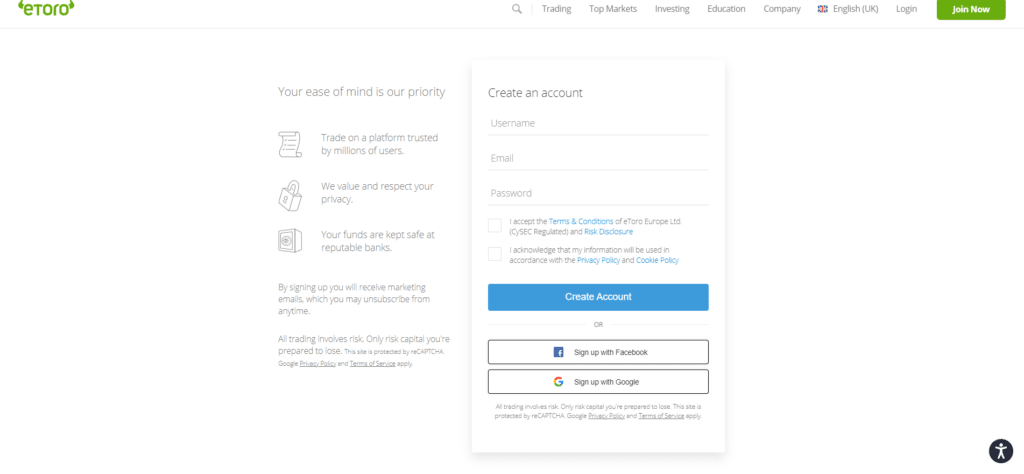
STEP TWO:We will now need to find Amazon shares within the eToro Investment Dashboard. Simply search for “Amazon” in the search bar at the top. After that, by clicking on the blue “Trade” button we will be able to choose all the details of our investment.
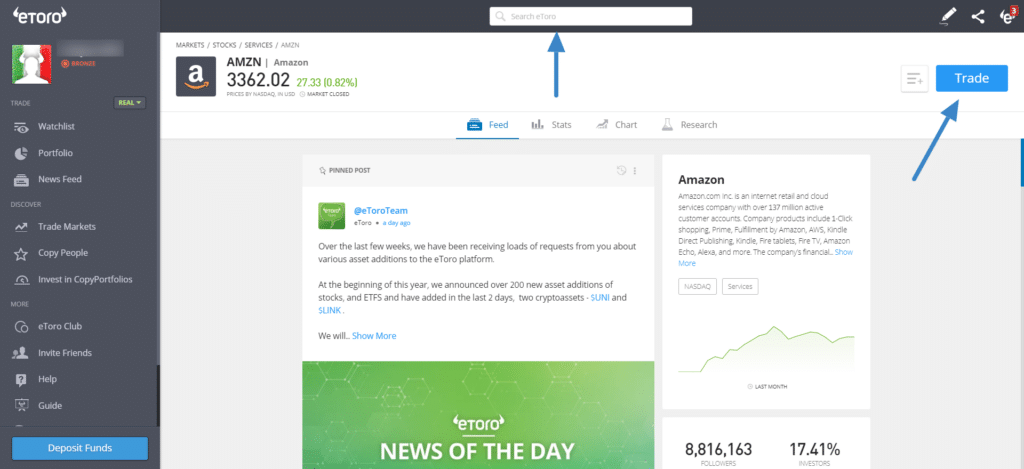
STEP THREE: Let’s choose all the details of our investment, such as the amount of money we want to invest and any leverage. Remember to choose “SELL” at the top, so we can invest in a short position. After completing the selection of details, click on “Open Trade” to open your investment.
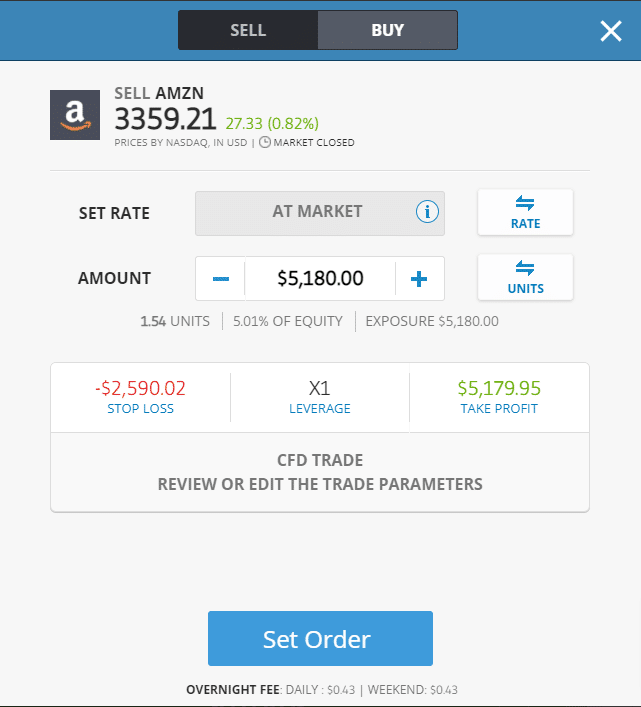
- Sell EUR/USD short with Capital.com
EUR/USD is the most liquid of the Forex pairs and by taking a short position we will have the opportunity to bet on the rise of the second component of the pair, that is in this case the US dollar. We will place this test order with Capital.com.
STEP ONE: Again, we will have to open a demo account with Capital.com. It is one of the easiest and fastest to open: we will just have to enter an email address and a password to access the platform. Once these details are entered we will have immediate access to the platform, but keep in mind that you will have to verify your identity to trade with real money.
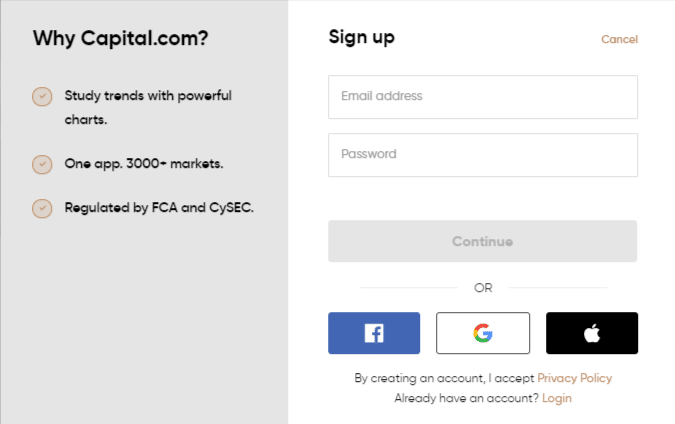
STEP TWO: From the Capital.com platform we will have to find EUR/USD. We can find it by scrolling down the menu, getting to FOREX and then choosing USD. On the list that shows up, as you can see in the image, it is possible to find EUR/USD. Otherwise, you can use the search bar as we did before on eToro. Now let’s click on the correct pair and choose SELL.
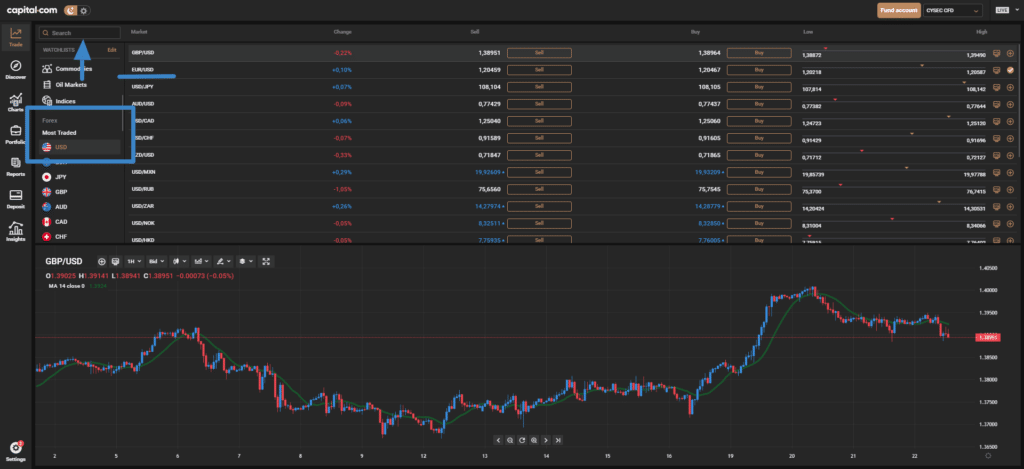
STEP THREE:We will now have to place the order. We will set the amount of money to invest, and we can also activate take profit, stop loss or order at a different price than the current one. When all the details are correct, just click SELL to open our short-sell position on EUR/USD.
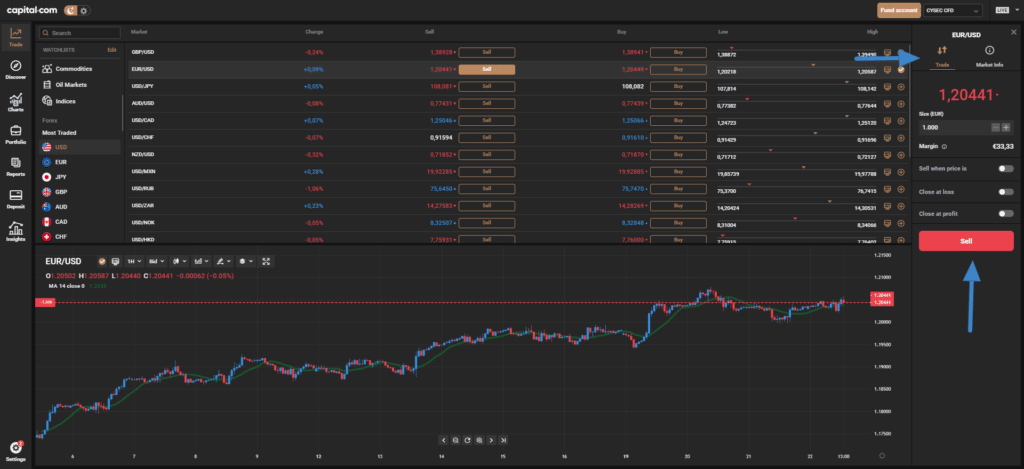
- Selling Gold Short with Iq Option
Gold has a strongly anti-cycle trend and can also have long recessionary periods at the price level, which opens important opportunities to trade short both for profiting and for hedging purposes. We will do so, in our test order, with IQ Option. This broker, which is available almost all over the world, is famous for having a very low minimum deposit (just €/£/$10).
STEP ONE: Let’s open a free demo account with IQ Option – an account that allows us to have access to virtual capital to test the platform’s functionality and also our trading strategies. Once on the registration page, click on OPEN AN ACCOUNT FOR FREE, enter a valid email address and password. Then click on REGISTER. We will be automatically directed to the IQ Option web platform.

STEP TWO: Now we will have to get to the Gold chart, from which we will place our order. Let’s click on “+” at the top, then go to “Commodities” and then “Gold“. Let’s click on it to access the chart that you will see on a screenshot right after this paragraph. On the right side, we will be able to place the order details.
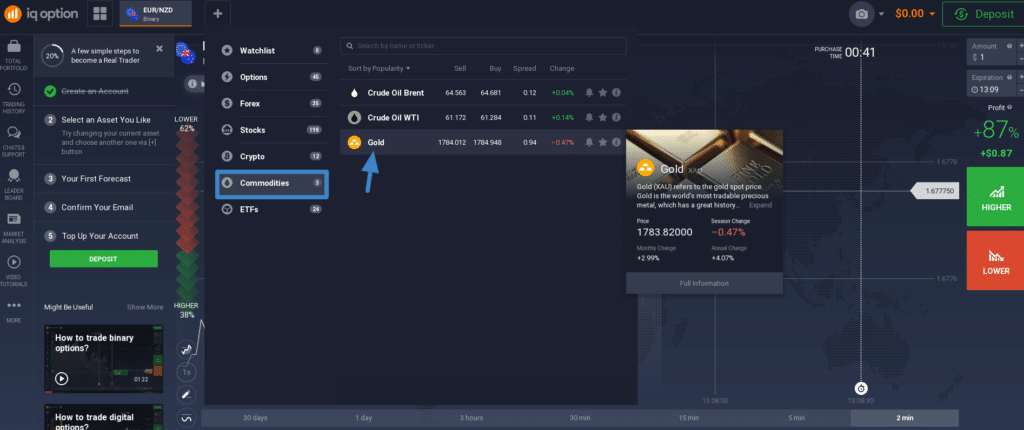
STEP THREE: Here we can set the amount of money to invest, the leverage to apply and other details. When the details of our order are correct, we can execute the short sale by clicking SELL. In the “Portfolio” section you will be able to monitor all your open orders and close them whenever you want.
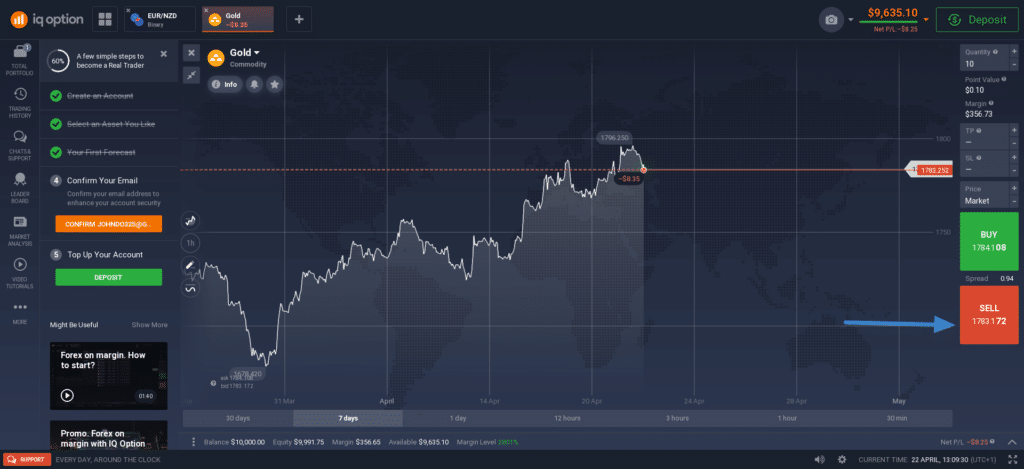
- Sell DAX 30 short with Trade.com
DAX30 is the index that allows you to invest in the 30 best stocks that are listed on the Frankfurt Stock Exchange, in Germany. To sell this stock short, we will proceed with Trade.com, a multi-asset broker that has always offered the possibility to operate also with leverage.
STEP ONE: open a demo account with Trade.com. Enter your First Name, Last Name, Email and Phone number to switch to the free demo account with virtual capital. Once we have entered these details, we can switch to the platform by clicking on “Create Account”.
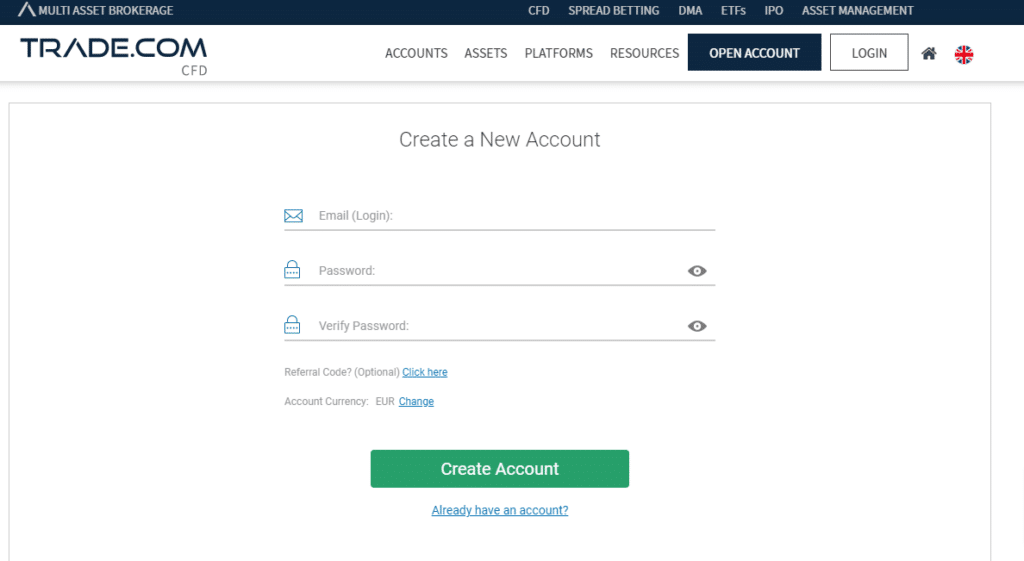
STEP TWO: We have already been redirected to the trading platform of the broker Trade.com. We will now need to access the DAX chart, available from the “Indices “ menu on the left. We then click on “Germany 30”, with which the broker signals the DAX 30 and we will find ourselves in the chart that we attach to our guide right after this paragraph.
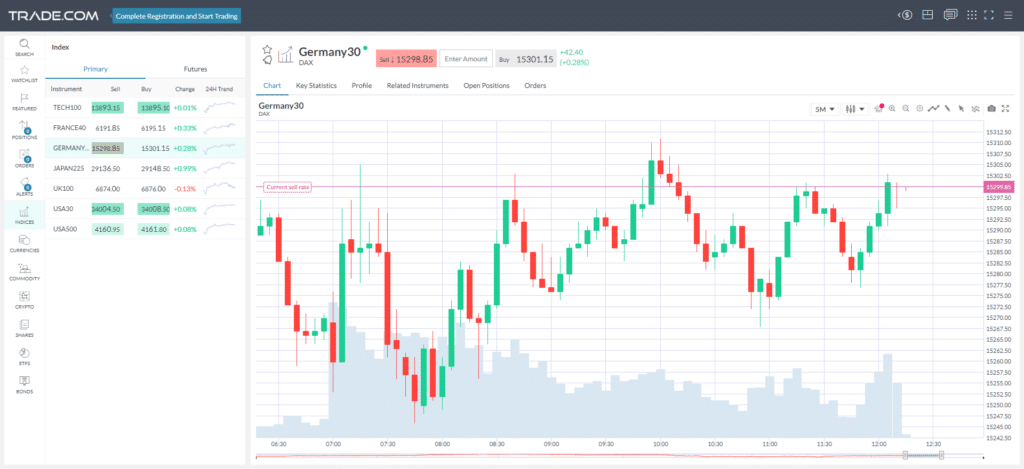
STEP THREE: let’s place the short sale order by clicking on SELL and completing the details of our investment. Also here we will be able to set take profit, stop loss, as well as other types of details such as the order triggered at a certain price level. We click on INSERT ORDER and we will have placed our first short sale order on Trade.com and DAX30.
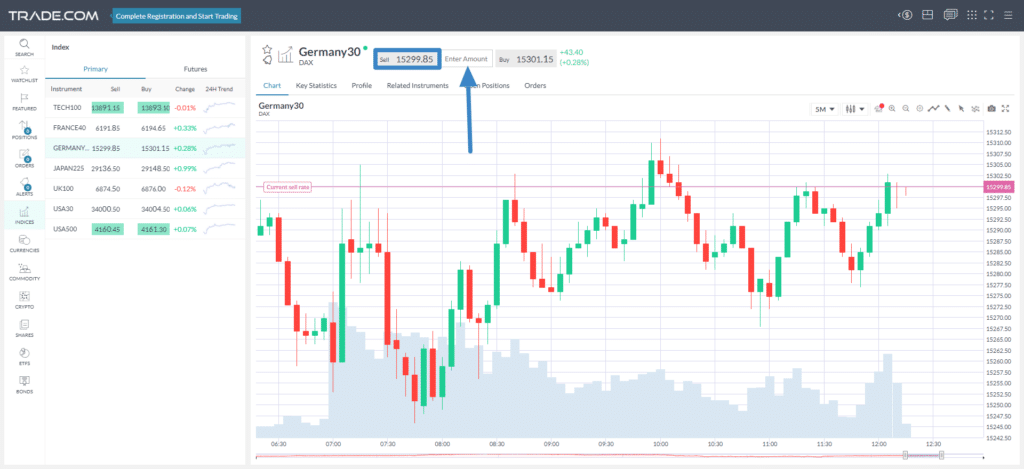
Where to do short selling: best platforms
67% of retail CFD accounts lose money.
67,7% of retail CFD accounts lose money.
48% of retail CFD accounts lose money.
79,90% of retail CFD accounts lose money.
After the table, let’s get to know more closely what are the features of the best brokers for short selling.
eToro is a mixed CFD and DMA broker that offers short selling on all securities in its offer, which is currently over 2,100. Like all CFD brokers, it applies a double commission, namely the spread and overnight commissions. When comparing these two costs with the market average, they appear to be very convenient.
eToro is a European broker with a regular license, which permits as we did just above to open a demo account at zero costs. In this way it also allows us to test our trading strategies with short selling using virtual money, thus running fewer risks. Definitely one of the best brokers overall, with a particular convenience when it comes to short selling. Not only for the tight spreads, but also because it allows you to manually select the leverage you want to use on your trade, giving you more control on your investments.
For those who want to combine this type of operation with more classic trading, it is worth mentioning that eToro also offers zero commission shares, in DMA mode, on the same platform and with neutral access to all major markets around the world. At least for now, however, you cannot short real stocks using eToro.
Note for U.S. Traders: even if eToro is available in the United States, CFDs cannot be offered to american investors. Giving that eToro does not allow traders to short-sell real stocks, U.S. traders do not have the possibility to open short positions to this date.
Capital.com is a pure CFD broker, duly licensed by the European Union and with over 3,000 stocks on its lists today, all open to short selling.
Also in this case, as with the previous one we mentioned, we have a broker that offers this type of instrument with ease and at a very low cost, in order to have all the instrumentation that was once only available to professionals. We can also count on an A.I. powered by Capital.com that analyzes or trades to give us personal suggestions on how to become more profitable.
Capital.com provides its clients with three different platforms: the one it owns, developed by the broker itself, Metatrader 4 and TradingView. You can test Capital.com in demo mode (free and unlimited), with no costs included and without any kind of obligation to switch to a real account later.
Trade.com is a multi-asset broker that also offers a very rich CFD section, with over 2,300 securities to invest in. Trade.com’s free demo account offers access to its own proprietary web platform, which allows you to invest with virtual capital and at no additional cost.
With this broker, you can trade stocks from all over the world and many commodities, for the world of Forex currencies and also for indices and bonds, as well as cryptocurrencies. If you want to focus on futures, you have one of the most complete lists of tradeable futures that you can find on an online trading platform.
A complete broker that allows us to make all the experience we need without costs, and then eventually switch to the real account and also use MetaTrader, the best possible platform for online trading, at least according to specialists. If you choose to trade on Metatrader, the number of assets you can trade will be restricted; to compensate for that, you will be able to access exclusive features such as automatic trading signals and algo trading.
IQ Option owes a significant part of its popularity to the fact that it is the only broker in the world that offers real accounts with only 10 euros, pounds or U.S. dollars of investment. A particularly low sum, which allows everyone to have access to professional trading equipment.
It offers short selling on the selection of securities – small but of quality – that it makes available to its clients. It will not have the thousands of stocks we have seen with the other brokers mentioned, but it still offers great spreads on Forex, stocks, commodities and cryptocurrencies. Here you can open a demo account with IQ Option and start trading with 10,000 USD of virtual capital.
Depending on the country where you declare to reside, you may also be able to trade binary options on Iq Options. For example, French traders can not access this asset class as European laws do not allow brokers to offer binary options to retail traders. In most of Central and Latin America, as well as in some Asian countries, they are still completely legit and available on the platform.
The equivalent of a short sell using CFDs, when using binary options, is a PUT option. In this case, you will be rewarded if you successfully predict the downfall of a financial asset. Keep in mind that binary options are more speculative and potentially riskier than CFDs, so you should be even more careful.
Learn how to short sell
You can learn how to do short selling with books, video courses and trading courses: it is such a basic topic that it is covered by practically any kind of market guide, although not all of them can be considered as equally valid. For this reason with our editorial staff, we have decided to propose a guide that is able to explore the topic with concrete and factual information.
Top short selling books
Short selling is one technique of many that we can implement to manage our portfolio. Therefore it becomes very difficult to find books that deal exclusively with this topic. This is not so bad, because we can find specific insights on the subject in very interesting books about the world of trading.
- A Beginner’s Guide to Day Trading Online by Toni Turner
A simple book that covers all the basics of online trading, including short selling. The book is designed for novice traders who want to learn how to do speculative online trading, also taking advantage of investments on the downside of financial instruments. Since it was first published, it has been a best-seller. In 2007 a new edition came out, that is still today one of the 50 most read books about economics in the United States.
- How to make money selling stocks short by William J. O’Neil
A book entirely dedicated to short selling, how to use it in the best way in your investment strategies and its role in the financial markets. A manual of a more technical nature, which closely analyzes the characteristics of a stock on which you can successfully make a short sale investment. Balance sheet data, fundamental analysis and other topics requiring intermediate financial market expertise are mentioned.
- Short Selling for the long term by Joseph Parnes
An unconventional book that approaches the topic of short selling from a unique perspective. Many, including us, find this tool useful primarily for the short term. Parnes’ approach is contrary and it is absolutely recommended for those who want divergent, but intelligent, opinions on short selling. What we like most about this book is how it manages to focus on the bright side of short selling. It shows exactly how the markets overprice some assets, and how short-sellers can take advantage of them and make the markets more efficient at the same time..
Short selling video courses
Even free video courses can help us to understand the real magnitude of the world of short selling. We have selected three videos to further explore the topic. All videos use a different approach, but they are all very simple.
- How short selling works di The Plain Bagel
The Plain Bagel has one of the best informative channels on Youtube. It deals with the world of financial markets from every point of view, including the basics of short selling. In this short video explains the mechanisms we talked about in the guide, with the addition of some animations that make it very entertaining.
Before watching the video, we have to inform you about a controversial point that is discussed towards the end. The author claims that when an investor shorts an asset, he can virtually lose more than he invested. This is not the case anymore, at least in most countries, as brokers must legally protect traders against negative balance.
- How to short a stock di ClayTrader
In this video of about 20 minutes we get to the practical aspect. The author shows you how to invest short on AT&T stock, showing every practical step you need to follow to execute the trade. It’s the same steps we’ve seen in our examples, but with one difference: instead of using a CFD broker to avoid commissions, ClayTrader sells short actual shares. In Europe, in the UK and in Asia it is quite uncommon for retail traders to short sell un underlying asset.
In the USA, this is different. Although you cannot do naked short sells (short selling without actually borrowing the asset from someone), you can short sell actual stocks with reasonable commissions even without using derivative contracts.
- Why is short selling legal? by CNBC
This video was made by CNBC right after the whole world stopped talking about what happened with Gamestop stock. In case you missed it, some Reddit users cooperated to massively buy shares of Gamestop, a chain of stores dedicated to gaming, whose stock had been heavily shorted by some hedge funds. Reddit users managed to skyrocket the value of Gamestop’s shares, leading even the mainstream media to talk about short selling.
The video is very basic, as it is targeted at an audience of first-time investors. The cool thing about it is how the story of Gamestop shares is narrated in the background: being one of the weirdest moments in the recent history of financial markets, we really think that traders should know at least the basics of what has happened.
Short selling opinions and reviews [2021]
Short selling is a useful tool available today to traders and savers with non-speculative strategies. Here we have collected the trading opinions of our editorial staff, as well as those of third parties that we can consider reliable and that may offer insights for further exploration of the topic.
Is it worth trading short?
Short selling should be seen as an additional tool that we have today to trade online and to make a profit even in situations where the market falls.
We also share the opinion of those who say that short selling is a tool for experts, for traders who have already gained some experience and know-how to operate using advanced tools. A certain level of experience should also be required by those who invest in the opposite direction, i.e. betting on the rise of security.
Even if the markets remain in a bullish phase for longer than they do in a downward phase, even when investing on the upside of equities one must be aware of the risks.
To stay strictly on the convenience of short selling, brokers today offer low-cost CFDs, which has made short selling effectively accessible to everyone.
Moreover, the complex procedure we have described in the initial phase of this study is now automatically handled by the trading platforms: we do not have to worry at all about finding counter-parties, borrowing securities, etc. This also helps to make the tool convenient.
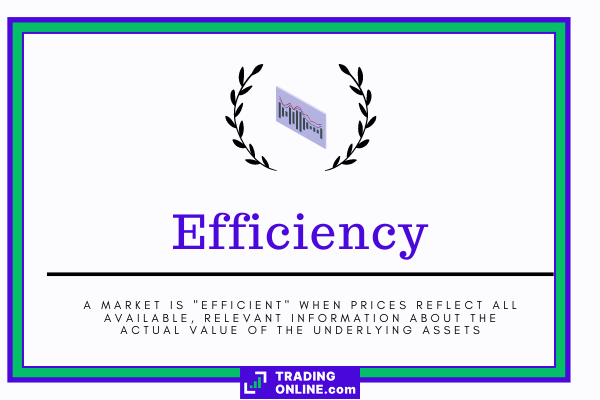
Short Selling: Pros and Cons
Short selling definitely has pros and cons that must be evaluated before using the tool and especially before you decide to integrate it into your strategies. We will analyze what we believe to be the advantages and disadvantages of this specific tool also in order to offer our readers a clear analysis of what happens when we operate with short selling.
Advantages of short selling
- Excellent system for hedging
The practice of hedging allows you to hedge against risks for investments that have an inverse correlation. The typical example is that of a short position on EUR/USD – and therefore short selling of US dollars – to protect oneself from the exchange rate risk of an investment in US stocks. We could give hundreds of other examples to illustrate the additional usefulness of short selling in this regard.
We believe that the use for hedging purposes is indeed one of the main and most useful – which can only be at least in our opinion the biggest advantage of using short selling.
- Earn money while the markets are falling
There are many examples of financial market crises. It is no longer even necessary to recall the subprime mortgage crisis in 2008/09. The crisis due to the COVID-19 pandemic has reminded everyone that there can be periods, even relatively long ones, during which markets fall.
Short selling allows you to have a useful tool to invest in the stock market even in these moments of turbulence while investing on the upside during a recession would result in easy losses. And this can only be a huge advantage offered by short selling.
Disadvantages of Short Selling
- A powerful tool
As much as freedom is always good, even for investors, mismanaging freedom can become a problem. Short selling today puts into everyone’s hands the ability to access complex positions that with leveraged trading can become very risky.
Some fail to manage this freedom and take the advantage of short selling to take unsustainable positions with a level of risk much higher than legal and reasonable. Like all tools that the world of online trading makes available, they must be used carefully.
- Borrowing Costs
As we mentioned, short selling involves a loan of securities or, in the case of CFD brokers, a loan for the money that keeps the position open. Interest is therefore charged to our account in the form of overnight fees. It is also true that due to the great competition between brokers these rates are very low.
In the world of CFDs, overnight commissions are always charged on positions. With short selling, however, the rates are lower than with long positions.
Short Selling: Recommended Forums
We would like to give a shout out to five forums that are an excellent starting point for discussions regarding short selling and trading. These are the forums that we think are the best because, in addition to in-depth discussions on these types of instruments, they offer many other useful discussions for those who want to trade in the right way.
Reddit has become a very relevant place for investors to share strategies and express their opinions. There are many sub-reddits where you can find comments and posts about short selling. The most prominent is r/investing, where you will find thousands of investors talking about short selling every day.
- Investing.com
Born as a website to access market data, it has become increasingly popular as a forum. There is plenty of room to meet other investors and talk about short selling on Investing.com. The most popular places to do so are under the price charts and inside the specific “forum” section.
- Moneyforums by Citywire
If you are looking for a very diverse forum, this one is for you. You will find threads about everything that involves money, from filing taxes to short selling. It is also a very popular choice among international users, making it easy to hear opinions from people located all over the world.
- Analystforum.com
Analyst Forum has a level of discussion above average. The target here is experienced traders who focus on short-term investing, which makes it a very good place to talk about short trades. You will almost certainly find interesting analysis and opportunities, which is why we really love this forum.
- MoneySavingExpert Forum
Another incredibly diverse forum, where users discuss everything from credit cards to speculative trades. We find it a good way to learn about personal finance in general, where short selling is discussed as part of the wider picture of the many ways you have to invest your money.
Our opinion on Short Selling
Our opinion is that supply and demand should not be limited: short selling is important for the markets and their proper functioning, and we are happy to have this tool available to small traders as well.
We believe that controversies about short selling and trading are pointless, especially when they come from authorities and governments that periodically block them, without any scientific grounds.
Those trading on the European stock exchanges, in particular, will also have noticed a block on short selling during the recent COVID19 crisis in the hope of keeping the prices of certain stocks artificially high. We are not alone in this struggle with regulator intervention in the event of a major crisis. There is a substantial body of scientific literature suggesting that the moral issue of short selling should be eliminated once and for all. Short selling is functional to the markets and enables them to establish a real and concrete price for each instrument.
We strongly oppose bans, even in the most heated moments of crisis, for the following reasons:
- Market Distortion Effect
Markets know how to do only one thing – their hive mind is able to price, very efficiently, any type of asset. Intervening by prohibiting short positions has distorting effects on this mechanism, reducing the efficiency of the markets with damaging effects on the entire financial system.
- The “positive” effects are extremely limited, while the negative effects are long term
The positive effects on stock prices, where they have occurred, have always been very short term. There are tons of data demonstrating that the price of shares in times of crisis tends to conform to what the market considers “right”.
- Slows down recovery
The short sale ban on a stock slows its recovery and lowers its trading volume. This is certainly not desirable.
So, are the authorities that intervene to protect companies listed on their markets wrong? In our opinion and in the opinion of the top echelon of financial researchers, yes. After all, “the road to hell“, as the old saying goes, “is always paved with good intentions“. The situation is different for the individual investor who wants to access this type of instrument via CFDs. In this case, the suitability must be evaluated on a personal level, taking into account various aspects concerning short selling:
- It is a more risky position
Because even during a crisis there are a lot of price rebounds, so you risk entering with a short position, being faced with a rebound, and losing almost all your capital. We are not talking about an easy way to earn money, but about a speculative investment like the classic stock purchase.
- It is generally a short-term position
It is almost useless, especially in the stock market, to bet with short selling for long-term investments. It is a fundamental rule of this instrument that we should never forget. Between the costs involved, the ability of stocks to incorporate inflation and long-term stock market trends, it is absolutely unreasonable to actually expect the price of a stock to go down forever.
Final considerations
Short selling is a tool that is often criticized but, at least according to our editorial staff, it should be respected both ethically and practically. We have investigated its possible uses, not only the speculative ones, and we have talked about how successfully it can be used.
This is to date the only one tool to offer profits when markets are falling and low-cost protection with hedging positions. The tool, which is now widely available also thanks to the arrival of CFDs in the market, can be a useful addition to the normal way investors operate.
Always keep in mind that there is technically no limit to the amount you can lose on a short trade, and that markets tend to rise over time so it’s harder to figure out when to short an asset. Beside these two factors, the is no actual reason for an investor to avoid this kind of operation. Short selling should be respected as a powerful way to make demand and supply for financial instruments meet at a fair price at any given moment.
What is short selling?
It is a trading tool that allows us to bet on the decline of any security.
What are the assets that I can short-sell?
You can practically short any asset, from Forex to stocks, through cryptos, commodities and even ETFs.
Is short selling risky?
Short selling is generally riskier than investing in the opposite direction, as there is no limit to the amount you can lose (an asset price could grow indefinitely) and because markets have the tendency to grow, not shrink, over long periods.
Which brokers offer short selling?
Almost all brokers that offer CFDs also have the option to short-sell these contracts, namely eToro, Trade.com, Capital.com, Fp Markets and Iq Option.
Is short selling difficult?
Nowadays shorting an asset is very easy. Most platforms only require you to click on “sell” instead of “buy” when you open your trade.
What can short selling be used for?
You can use it both for speculative trading and for hedging, i.e. hedging against the risk of other positions to protect you from certain market conditions.
How much capital is needed to invest with short selling?
You need the capital to invest on margin and hedge price changes. Some online trading brokers, such as IQ Option, allow you to start with as little as 1 euro per position and a 10 euro minimum deposit to open an account.











